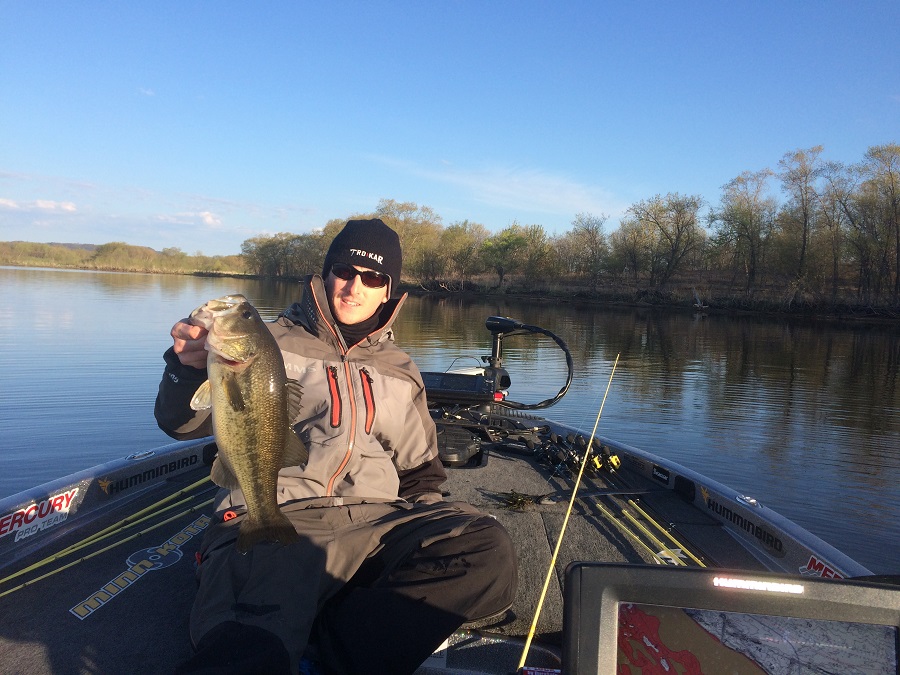
Looking in the mid-depth range by casting a War Eagle Spinnerbait resulted in this healthy late fall largemouth.
For anglers in the northern half of the U.S., the term fall turnover brings about several thoughts and questions.
What is fall turnover?
A lake turnover is occurs when the lower layer of the lake, mixes with the upper layer of the lake. All of this happens in a short duration of time.
Locals or regulars to a certain lake will develop their own opinions on what happens during the turnover and many times blame tough fishing conditions or fish kills on the turnover.
Are bass affected by the turnover?
What researchers have discovered is that bass are affected by the turnover, some more than others, but how long they are affected is typically just a few days. The bass that spend the majority of their year in deep water and only go shallow to spawn in the spring will be the group of bass that affected the most.
Do all lakes have a turnover?
Big bodies of water that have current, either from a river or wind will rarely experience a fall turnover. If it does occur, it will be very minimal and the effect on bass will also be minimal to non-existent. This is because the water is being stirred up all season long, resulting in the lake’s water being very similar across all depths.
Targeting bass during the fall turnover?
If the body of water you are fishing does experience a fall turnover and the fishing does just seem “off,” the easiest thing to do is come back in a few days and it will be back to normal, but as a fisherman we all know that fishing is fishing!
If you are fishing a lake that is in the process of a turnover or just has gone through it, be thinking about the bass you caught deep during the summer months.Those bass were positioned near the thermocline.
The turnover has now eliminated that, so bass have no restraints on where they can go. They may be deeper than they were during the summer, or they may have pushed up shallow with the population of bass that live up there all season long.
Keeping a keen eye to the water you are fishing will aid in you visually being able to identify that the fall turnover has occurred or is happening. If you notice that the water clarity has suddenly decreased dramatically and there are clumps of dead or dying vegetation on the water’s surface, then you know turnover has happened.
You can also identify that the turnover has happened by using your electronics. I’ll turn the sensitivity on my Humminbird HELIX unit way up and idle around in deep water. If I see baitfish scattered across all depths, I’ll know that lake is in turnover mode.
Being that the bass are now “free range”, you’ll want to rely on presentations that allow you to cover the greatest amount of water as possible.
Three great presentations to accomplish this include:
- Spinnerbaits – This is a very popular fall lure, as it can be cast far, retrieved at various speeds and depths and the changing up of blade combinations make this lure extremely versatile. Lure Choice: A War Eagle Screaming Eagle spinnerbait is my top choice as it weighs a ½-ounce, but is on the frame of a 3/8-ounce spinnerbait. This allows me to burn the bait with ease.
- Swim Jigs – Fishing a ¼- or 3/8-oune swim jig is a great technique to use, if you are covering water that is 6-feet or less and there are still some clumps of vegetation or you are fishing around vegetation in shallow water that is still present. Tip: Switch up the trailer on your swim jig, if the bass are short striking, I’ll commonly go from a Zoom UV Speed Craw to a Super Speed Craw as the bulk gives the bass a bigger profile to key in on.
- Crankbaits – Another great lure choice that helps you cover water quickly to locate schooled up fall bass if a crankbait. Selecting a crankbait that will just come in contact with any remaining vegetation is key. Tip: Switching your line size will affect the depth at which your crankbait runs. If you want to get your crankbait to run deeper, decrease the line size. Likewise, if you want the bait to run shallower, increase the line size. For me, I’ll begin with 15-pound-test Seaguar InvizX Fluorocarbon and then increase or decrease the line size as needed.
Don’t be afraid if your favorite lake has turned over or is in the process of turning over, bass still have to eat and if the fall weather is good you might as well feed em your favorite lure!
For more information check out glennwalkerfishing.com or on Facebook at facebook.com/glennwalkerfishing.


 Advertising
Advertising